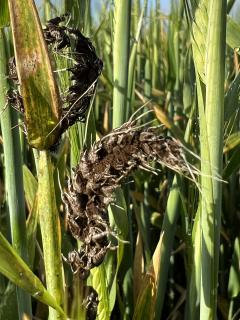Barley loose smut – this year and going forward
Loose smut is more prevalent in WA barley crops this year primarily due to the conducive spring conditions experienced in 2022. When last years crop was heading during spring, the few infected heads present had an excellent opportunity to spread infection to developing grain. After growing out grain this year, a noticeable rise in the number of plants exhibiting infected heads compared to the past few years has become evident, particularly in the susceptible Hindmarsh family of varieties.
Since loose smut stands out in crops, it is easy to overestimate the actual level of infection present. However, if there are mild conditions during flowering this year, there are likely to be more than enough smut spores around to continue the cycle of infection. Therefore, growers are advised to treat seed for next season with registered fungicide seed dressing to prevent it producing smutted heads in 2024.
Seed treatment
While growers may feel disappointed when their crops get infected with loose smut after applying a seed dressing that is registered for smuts, the effectiveness of seed treatments relies on precise application. Even under optimal conditions, smut still has the edge. For example, in a scenario where a 10 x 10 m square of crop contains 10 to 12,000 plants, even if the seed control rate is as high as 95% and the initial seed infection is only 0.5%, this will still result in an average of three infected plants evading control in that 10 x 10 m area.
The barley variety Maximus CL has a pedigree of Scope, Fathom and La Trobe. This suggests that the La Trobe heritage might be prone to loose smut infection. However, DPIRD does not have trial data directly comparing it to other varieties yet.
DPIRD trials conducted in 2018 revealed that SDHI seed dressings, such as Vitaflo, Vibrance and EverGol Energy, all provide excellent control greater than 95% while other registered products tested are still effective (>60% control), but not quite as good (see Table 1). It is important to note that in these trials the seed dressing products EverGol Energy and Rancona Dimension were tested at the lowest rate registered for loose smut at the time.
| Seed dressing | Rate (L/t seed) | Infection reduction (%) | |||
|---|---|---|---|---|---|
| Gibson | Katanning | Wongan Hills | All sites | ||
| Untreated | 0 | 0 | 0 | 0 | 0 a |
| Baytan T | 1 | 69 | 67 | 67 | 67 c |
| EverGol Energy | 1.3 | 100 | 99 | 100 | 99 e |
| Rancona Dimension | 0.8 | 55 | 60 | 64 | 60 b |
| Raxil T | 1 | 70 | 79 | 74 | 74 d |
| Vibrance | 1.8 | 95 | 96 | 98 | 96 e |
| Vitaflo | 2.5 | 99 | 99 | 91 | 96 e |
| Average | - | 73 | 74 | 74 | 74 |
For more fungicide information refer to DPIRD’s seed dressing and in-furrow fungicides for cereals in WA page.
Further information on loose smut
To read about earlier loose smut activity this season refer to the 2023 PestFacts WA Issue 12 article loose smut in barley.
For more information on barley loose smut, refer to the department's webpages:
- Diagnosing barley loose smut.
- Controlling barley loose smut.
- Smut and bunt diseases of cereal - biology, identification and management.
For more information, contact Plant pathologists Andrea Hills in Esperance on +61 (0)8 9083 1144, Kithsiri Jayasena in Albany on +61 (0)8 9892 8477, Geoff Thomas in South Perth on +61 (0)8 9368 3262, Ciara Beard in Geraldton on +61 (0)8 9956 8504 or Kylie Chambers in Northam on +61 (0)8 9690 2151.
Article author: Andrea Hills (DPIRD Esperance).
Article input: Kithsiri Jayasena (DPIRD Albany) and Geoff Thomas (DPIRD South Perth).

